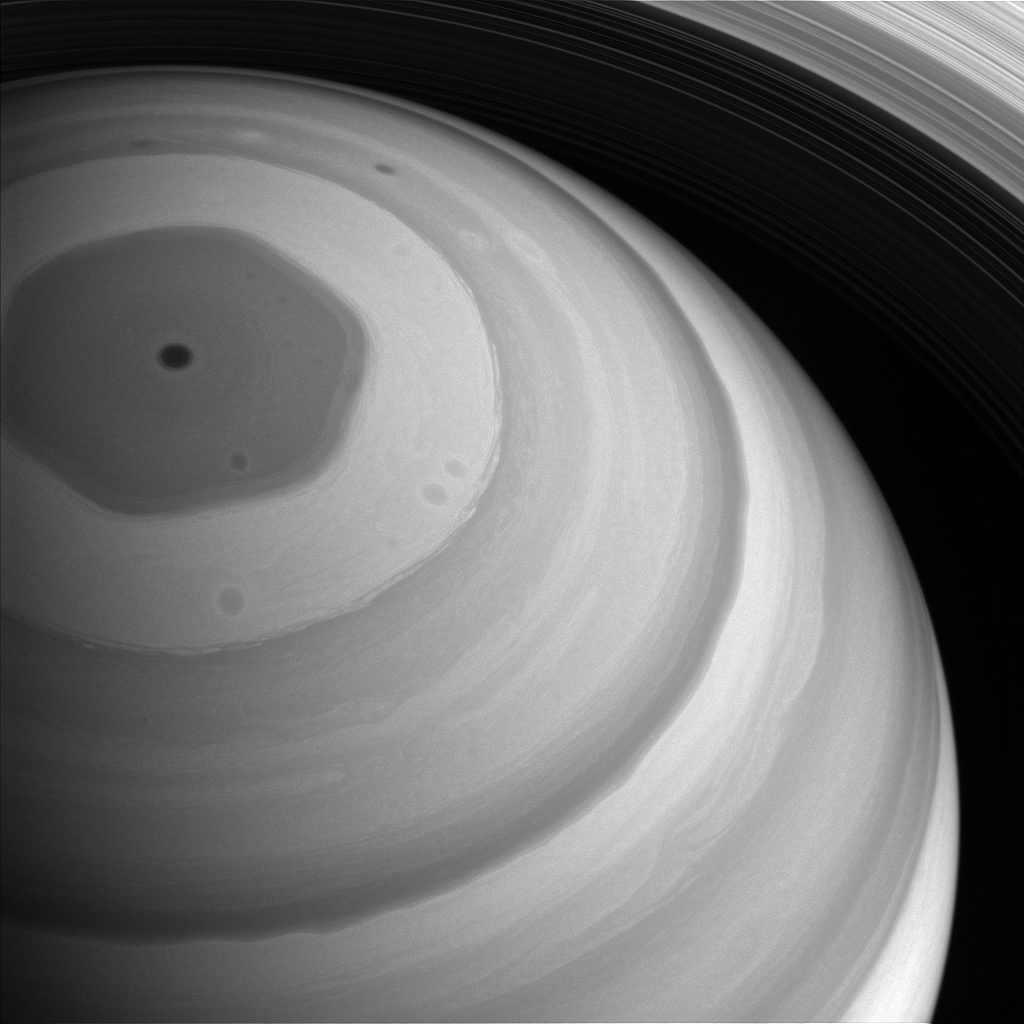story by Helen Hill for MITGCM

This month we spotlight work from Canadian researchers Yakov Afanasyev and Yang Zhang working at the Memorial University of Newfoundland who have combined MITgcm direct numerical simulations with physical fluid laboratory experiments in an exploration of what might be creating monster cyclonic vortices at the poles of Saturn.
Circulation of Saturnian polar atmosphere is quite unusual. It contains a bizarre hexagonal cloud pattern, first observed in 1980’s Voyager data and later confirmed by Cassini’s closer fly-bys, is about 20,000 miles (32,000 kilometers) wide, with a churning storm at its center that thermal images show reaches roughly 60 miles (100 km) down into Saturn’s atmosphere.
Besides the enigmatic cyclonic vortex at its pole, the general atmospheric circulation at other latitudes is dominated by embedded zonal jets displaying a similarly cyclonic circulation.
An abundance of small-scale convective storms suggests that convection likely plays a role in producing and maintaining the Saturnian atmospheric circulation. However the dynamical influence of small-scale convection on Saturn’s general circulation remains poorly understood.
Now researchers present experiments that suggest Saturn’s cyclonic circulation can be explained by tilted convection in which buoyancy forces out of alignment with the planet’s rotation axis tend to send small scale cyclones to the pole.
In their new study, published in Nature Geoscience in March, Afanasyev and Yang describe laboratory analogue experiments in which small scale convection merges to generate large scale cyclonic structures. In particular the merger of small scale cyclones, visually similar to those observed in Cassini, data create a strong vortex at the pole.
In their experiments using a cylindrical water tank heated at the bottom, cooled at the top, and spun on a rotating table; warm rising plumes and cold sinking water generate small anticyclonic and cyclonic vortices that are qualitatively similar to convective storms observed on Saturn.
Complementary numerical simulations performed using MITgcm using laboratory parameters, demonstrate that this small-scale convection can lead to large-scale cyclonic flow at the surface and anticyclonic circulation at the base of the fluid layer with a polar vortex forming from the merging of smaller cyclonic storms that are driven polewards.
To find out more about this work contact Yakov.

Yakov Afanasyev is a professor of experimental oceanic and atmospheric fluid dynamics at Memorial University of Newfoundland. He says he learned MITgcm specifically for this project: “It took me about one month to figure out how to setup the problem and 2-3 more month to run the simulations on Canada Compute computers.” When he is not modeling Saturn, he paints portraits, landscapes and still-life. http://yakovartstudio.blogspot.ca/
This Month’s Featured Publication
- Y. D. Afanasyev & Y. Zhang (2018), Cyclonic circulation of Saturn’s atmosphere due to tilted convection, Nature Geoscience, volume 11, pages164–167, doi: 10.1038/s41561-018-0070-3
Related Publication
A. G. Slavin, Y.D. Afanasyev (2012), Multiple zonal jets on the polar beta plane, Phys Fluids, 24, 016603, doi: 10.1063/1.3678017
Other New Publications this Month
A. Bigdeli, T. Hara, B. Loose, A. T. Nguyen (2018), Wave Attenuation and Gas Exchange Velocity in Marginal Sea Ice Zone, Journal of Geophysical Research – Oceans, doi: 10.1002/2017JC013380
Mohamed El Sayed Shaltout and Kareem Mahmoud Tobal (2018), Downscaling Global Climate Models: The case for Egypt, Alexandria Research Centre for Adaptation to Climate Change, Alexandria University <pdf>
Mari F. Jensen, Kerim H. Nisancioglu, and Michael A. Spall (2018), Large changes in sea ice triggered by small changes in Atlantic water temperature, Journal of Climate, doi: 10.1175/JCLI-D-17-0802.1
Xiaolin Jin, Young-Oh Kwon, Caroline C. Ummenhofer, Hyodae Seo, Franziska U. Schwarzkopf, Arne Biastoch, Claus W. Böning, and Jonathon S. Wright (2018), Influences of Pacific Climate Variability on Decadal Subsurface Ocean Heat Content Variations in the Indian Ocean, Journal of Climate, doi: 10.1175/JCLI-D-17-0654.1
Vincent Le Fouest, Atsushi Matsuoka, Manfredi Manizza, Mona Shernetsky, Bruno Tremblay, and Marcel Babin (2018), Towards an assessment of riverine dissolved organic carbon in surface waters of the western Arctic Ocean based on remote sensing and biogeochemical modeling, Biogeosciences, 15, 1335–1346, doi: 10.5194/bg-15-1335-2018
Neill Mackay, James R. Ledwell, Marie‐José Messias, Alberto C. Naveira Garabato, J. Alexander Brearley, Andrew J. S. Meijers, Daniel C. Jones, Andrew J. Watson (2018), Diapycnal Mixing in the Southern Ocean Diagnosed Using the DIMES Tracer and Realistic Velocity Fields, Journal of Geophysical Research – Oceans, doi: 10.1002/2017JC013536
Galen A. McKinley, Alexis L. Ritzer, and Nicole S. Lovenduski (2018), Mechanisms of northern North Atlantic biomass variability, Biogeosciences Discuss., doi: 10.5194/bg-2018-89
M.Reale, F.Giorgi, C.Solidoro, V. Di Biagio, L.Mariotti and R.Farneti (2018), Preliminary results of the RegCM‐ES model with an active biogeochemical component
(BFM) over the Med‐CORDEX domain, International Baltic Earth Secretariat Publication No. 12, MedCORDEX-Baltic Earth-COST Workshop, Regional Climate System Modelling for the European Sea Regions, Universitat de les Illes Baleares, Palma de Mallorca, Spain, 14 – 16 March 2018 <pdf>
Richter, Friedrich; Drusch, Matthias; Kaleschke, Lars; Maaß, Nina; Tian-Kunze, Xiangshan; et al. (2018), Arctic sea ice signatures: L-band brightness temperature sensitivity comparison using two radiation transfer models, The Cryosphere, Katlenburg-Lindau Vol. 12, Iss. 3, 921-933, doi: 10.5194/tc-12-921-2018
V. Tamsitt, R. P. Abernathey, M. R. Mazloff, J. Wang, L. D. Talley (2018), Transformation of Deep Water Masses Along Lagrangian Upwelling Pathways in the Southern Ocean, Journal of Geophysical Research – Oceans, doi: 10.1002/2017JC013409
Do you have news about research using MITgcm? We are looking for contributions to these pages. If you have an interesting MITgcm project (ocean, atmosphere, sea-ice, physics, biology or otherwise) that you want to tell people about, get in touch. To make a post, contact Helen

